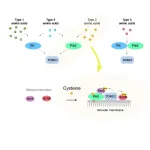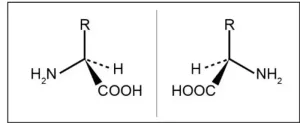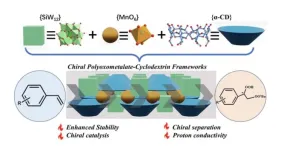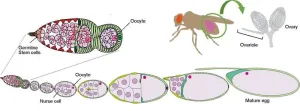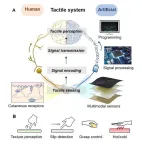(Press-News.org) While physicists continue to argue about whether time is indeed an illusion, as Albert Einstein claimed, biologists have no doubt about its significance for understanding life as a dynamic system. In recent years, they have been gaining an increasingly deeper understanding of complex biological systems using tools enabling the simultaneous analysis of vast amounts of cellular and molecular data and the probing of cellular circuitry that drives disease. However, these in-depth investigations of how cells behave and interact have provided only separate snapshots of what happens inside complex organisms, without accounting for the dimension of time and revealing the sequence of cellular events.
Now, in a new study published today in Cell, researchers from Prof. Ido Amit's lab at the Weizmann Institute of Science have managed for the first time to develop a method for tracking and measuring changes over time on in single cells inside the body. The method, called Zman-seq (from the Hebrew word zman, for “time”), consists of labeling cells with different time stamps and tracking them in healthy or pathological tissue. Using this cellular time machine, researchers can get to know the cells’ history and how long each cell had stayed in the tissue, ultimately achieving an understanding of the molecular and cellular temporal changes that had taken place within that tissue.
Single-cell technologies, the tools that enable biologists to understand what happens inside individual cells, have advanced significantly in recent years, in large part thanks to the vibrant single-cell research community in which Amit’s lab is one of the pioneers. With these tools, it is now possible to obtain high-resolution images of how diseases develop and how the body responds to different medications, to identify rare cell populations, decipher which cells interact with one other and how they are spatially distributed in a tissue. However, all these important insights are equivalent to getting many still-frame images from a movie and trying to understand the plot. “Knowing what preceded what is not enough to deduce causality, but without this knowledge, we don’t really have a chance of understanding what the cause is and what is the effect,” Amit says.
The development of the groundbreaking new technology started with the research of Dr. Daniel Kirschenbaum, a postdoctoral researcher in Amit’s lab. Kirschenbaum was born in Hungary and did his PhD in neuropathology in Switzerland, where he studied glioblastoma, the most common and aggressive brain tumor. “We usually think of cancer as cells growing out of control, but in fact, cancer is also the loss of the ability of the body, and specifically of its immune system, to control this growth,” he says. “And when you look at tumors, large parts of them are composed of dysfunctional immune cells, which sometimes make up one third or even half of all the cells in a tumor.”
Glioblastoma is one of the most immune-suppressive types of tumors. “To understand how to defeat this cancer, we need to understand what happens to the immune cells as they enter the tumor and why they lose the capacity to fight the tumor and become dysfunctional,” Kirschenbaum explains. “Ideally, we’d want to have a little clock on each cell telling us when it entered the tumor and when the signals and checkpoints that instruct it to become incompetent are activated. This back to the future time machine was thought to be impossible to develop.”
The breakthrough came when Kirschenbaum decided to take an uncanny approach. “Instead of trying to measure time in cells within the tumor tissue, we decided to try to mark the cells while they are still in the blood – before they enter the tumor. By using different fluorescent dyes at different time points, we are later able to know exactly when each cell entered the tissue and how long it had been there, and this reveals the dynamic changes that happened to the cells in the tissue, for example, what are the different stages at which immune cells become dysfunctional inside the tumor.”
The challenge, Kirschenbaum adds, was to develop the optimal way to color the cells in the blood at specific time points, making sure the dye does not reach the tissue itself or stay too long in the blood, potentially mixing with the next dye. At the same time, the dye had to stay on the cells long enough for them to be measured. As part of the study, the researchers in Amit’s lab showed that the method makes it possible to measure time in immune cells in different tissues – the brain, the lungs and the digestive system of animal models.
Using Zman-seq, Kirschenbaum and his colleagues were able to gain insights into why the immune system is so dysfunctional in battling glioblastoma. “For example, we showed that immune cells called natural killer cells, which, as their name implies, are crucial to killing rogue cells, become dysfunctional very quickly because the tumor hijacks their killing mechanisms – and this happens within less than 24 hours after their entry into the tumor. This explains why therapeutic attempts to harness the immune system for fighting glioblastoma are so ineffective,” Kirschenbaum says.
Other members of Amit's lab in Weizmann’s Systems Immunology Department, including Dr. Ken Xie and Dr. Florian Ingelfinger, contributed to the development of Zman-seq. Collaborators included immunologists Prof. Marco Colonna of Washington University, Prof. Katayoun Rezvani of the University of Texas, Prof. Florent Ginhoux of the Shanghai Institute of Immunology, neurooncologist Dr. Tobias Weiss of the University Hospital Zurich, and computational biologists Prof. Fabian J. Theis of the Helmholtz Center Munich and Prof. Nir Yosef of the Weizmann Institute.
Now, researchers in Amit’s lab are developing ways to block the immune-disabling tumor checkpoints in order to reactivate the immune system in glioblastoma and other hard-to-treat tumors. In addition, they plan to adapt Zman-seq to the study of temporal dynamics of cells throughout the human body. “For example, many cancer patients are getting therapy before surgery. We want to use the method to color immune cells in the body during that period so that after the surgery, we can better understand the dynamics of immune cells in the tumor and optimize patient treatments,” adds Kirschenbaum.
“Until today, there were quite a few different methods trying to analyze single-cell data and arranging them along a time axis according to different parameters. But these approaches were all somewhat arbitrary in choosing what are the sequence of events," Amit says. “Zman-seq supplies the ‘hard facts,’ the empirical measurements enabling scientists to understand the precise order of events that immune and other cells are going through when they enter a tumor, and this may lead to a completely new thinking on how to generate more effective therapies for cancer and other disorders.”
Prof. Ido Amit’s research is supported by the Dwek Institute for Cancer Therapy Research; the Moross Integrated Cancer Center; the Morris Kahn Institute for Human Immunology; the Swiss Society Institute for Cancer Prevention Research; the Elsie and Marvin Dekelboum Family Foundation; the EKARD Institute for Cancer Diagnosis Research; the Lotte and John Hecht Memorial Foundation and the Schwartz Reisman Collaborative Science Program.
Prof. Amit is the incumbent of the Eden and Steven Romick Professorial Chair.
END
Back to the future: Weizmann Institute scientists develop the first method to measure cellular changes in the body over time
The method, called Zman-seq, reveals the history of cells and may advance the development of new therapies for cancer and other disorders
2023-12-21
ELSE PRESS RELEASES FROM THIS DATE:
The key mechanism to cell growth has been elucidated
2023-12-21
Osaka, Japan – Amino acids are the building blocks of life. We obtain them from the food we eat, and the body uses them to make proteins, which in turn are used for growth, development, and a multitude of other functions. However, before the body can build with these blocks, it must first be able to sense their presence.
When amino acids are available, a master regulator protein called TORC1 is switched on, causing proteins to be manufactured and cells to grow. If no amino acids are available, TORC1 is switched off, and cells start to recycle themselves in a process known as autophagy. Until now, it was unclear exactly how amino acids triggered the TORC1 switch in yeast.
Now, in a study ...
One of the keys to healthy sleep and blood sugar has been found
2023-12-21
Osaka, Japan – Only recently was it discovered that amino acids, the building blocks of proteins, exist in two different forms: L- and D-forms. While all natural proteins consist exclusively of L-amino acids, the function of D-amino acids remained poorly understood, despite being present in the food we eat every day.
Now, a multi-institutional research team led by Osaka University has revealed a function of one D-form amino acid: D-alanine. So, what does it do, and how did they uncover its function? To understand, we need a little background information.
The circadian clock, a natural ...
Artery calcification more common in night owls
2023-12-21
Artery calcification is almost twice as common in night owls compared to early birds, according to a study from the University of Gothenburg, Sweden. Circadian function appears to be particularly important during the early stages of cardiovascular disease.
Atherosclerosis involves fatty deposits accumulating on the inside of the arteries, making it harder for blood to pass through. The disease develops over a very long period of time and is not noticed until it leads to blood clots causing angina, heart attack, or stroke. Previous research has shown that people with late-night habits have an increased risk of cardiovascular disease, but this is the first study to show how circadian rhythms ...
Scientists create chiral POM-based frameworks with enhanced stability and catalytic activity
2023-12-21
A team of scientists has created a chiral assembly by blending inorganic polyoxometalates and organic cyclodextrin molecules. Polyoxometalates are a class of nanomaterials with many useful applications. But the use of polyoxometalates as building blocks to construct chiral POM-based frameworks has been a long-stranding challenge for researchers. In this research, the team produced a 3D framework, constructed by coordination assembly. The resulting framework features an interlaced organic-inorganic hybrid layer.
The team has published their work in the journal, Polyoxometalates, ...
Smithsonian-led study reveals five new species of soft-furred hedgehogs from Southeast Asia
2023-12-21
A new study led by scientists at the Smithsonian’s National Museum of Natural History identifies five new species of soft-furred hedgehogs from Southeast Asia.
The study, published in the Zoological Journal of the Linnean Society, used DNA analysis and physical characteristics to describe two entirely new species of soft-furred hedgehogs and elevate three subspecies to the level of species.
The two new species, named Hylomys vorax and H. macarong, are endemic to the endangered Leuser ecosystem, a tropical rainforest in North Sumatra and Southern Vietnam, respectively. The museum specimens that were vital to describing these two new species came from the natural history collections ...
Bugs that help bugs: How environmental microbes boost fruit fly reproduction
2023-12-21
Osaka, Japan – For many of us, when we think of microbiomes, our first thoughts are probably about the beneficial microorganisms that live in our guts. But now, researchers from Japan and US have discovered how the microbes living in fruit flies can enhance their reproduction.
In a recently published study in Communications Biology, the research group has revealed that microbes in the fruit fly microbiome are involved in controlling the germline stem cells that form eggs, as well as subsequent egg maturation, in female fruit ...
Sleep deprivation makes us less happy, more anxious
2023-12-21
Sleep loss does more than just make us tired. It can undermine our emotional functioning, decrease positive moods and put us at higher risk for anxiety symptoms, according to a study published by the American Psychological Association that synthesized more than 50 years of research on sleep deprivation and mood.
“In our largely sleep-deprived society, quantifying the effects of sleep loss on emotion is critical for promoting psychological health,” said study lead author Cara Palmer, PhD, of Montana State University. “This study represents ...
KIMM develops real-time multimodal tactile detection system applicable to robots and wearable devices
2023-12-21
A tactile perception system capable of providing human-like multimodal tactile information to objects like robots and wearable devices that require tactile data in real time has been developed.
The research team led by Research Director Hyuneui Lim of the Nano-Convergence Manufacturing Systems Research Division and Principle Researcher Youngdo Jung of the Department of Nature-Inspired System and Application of the Korea Institute of Machinery and Materials (Chairman Seog-hyeon Ryu, hereinafter referred to as the “KIMM”), an institute under the jurisdiction of the Ministry of Science and ICT, developed a real-time and ...
New 1.5-billion-pixel ESO image shows Running Chicken Nebula in unprecedented detail
2023-12-21
While many holiday traditions involve feasts of turkey, soba noodles, latkes or Pan de Pascua, this year, the European Southern Observatory (ESO) is bringing you a holiday chicken. The so-called Running Chicken Nebula, home to young stars in the making, is revealed in spectacular detail in this 1.5-billion-pixel image captured by the VLT Survey Telescope (VST), hosted at ESO’s Paranal site in Chile.
This vast stellar nursery is located in the constellation Centaurus (the Centaur), at about 6500 light-years from Earth. Young stars within this nebula emit intense radiation that makes the surrounding hydrogen gas glow in shades ...
Light exercise could be the key to reversing childhood obesity linked to sedentariness
2023-12-21
Increased sedentary time as a child through adolescence is directly linked to childhood obesity, but new research has found light physical activity may completely reverse the adverse process.
The study - conducted in collaboration with between University of Exeter, University of Eastern Finland, University of Bristol, and University of Colorado and published in Nature Communications – is the largest and longest follow-up to objectively measure physical activity and fat mass, using the University of Bristol’s Children of the 90s data (also known as the Avon Longitudinal Study of Parents and Children). ...
LAST 30 PRESS RELEASES:
Research suggests nationwide racial bias in media reporting on gun violence
Revealing the cell’s nanocourier at work
Health impacts of nursing home staffing
Public views about opioid overdose and people with opioid use disorder
Age-related changes in sperm DNA may play a role in autism risk
Ambitious model fails to explain near-death experiences, experts say
Multifaceted effects of inward foreign direct investment on new venture creation
Exploring mutations that spontaneously switch on a key brain cell receptor
Two-step genome editing enables the creation of full-length humanized mouse models
Pusan National University researchers develop light-activated tissue adhesive patch for rapid, watertight neurosurgical sealing
Study finds so-called super agers tend to have at least two key genetic advantages
Brain stimulation device cleared for ADHD in the US is overall safe but ineffective
Scientists discover natural ‘brake’ that could stop harmful inflammation
Tougher solid electrolyte advances long-sought lithium metal batteries
Experts provide policy roadmap to reduce dementia risk
New 3D imaging system could address limitations of MRI, CT and ultrasound
First-in-human drug trial lowers high blood fats
Decades of dredging are pushing the Dutch Western Scheldt Estuary beyond its ecological limits
A view into the innermost workings of life: First scanning electron microscope with nanomanipulator inaugurated in hesse at Goethe University
Simple method can enable early detection and prevention of chronic kidney disease
S-species-stimulated deep reconstruction of ultra-homogeneous CuS nanosheets for efficient HMF electrooxidation
Mechanical and corrosion behavior of additively manufactured NiTi shape memory alloys
New discovery rewrites the rules of antigen presentation
Researchers achieve chain-length control of fatty acid biosynthesis in yeast
Water interactions in molecular sieve catalysis: Framework evolution and reaction modulation
Shark biology breakthrough: Study tracks tiger sharks to Maui mating hub
Mysterious iron ‘bar’ discovered in famous nebula
World-first tool reduces harmful engagement with AI-generated explicit images
Learning about public consensus on climate change does little to boost people’s support for action, study shows
Sylvester Cancer Tip Sheet for January 2026
[Press-News.org] Back to the future: Weizmann Institute scientists develop the first method to measure cellular changes in the body over timeThe method, called Zman-seq, reveals the history of cells and may advance the development of new therapies for cancer and other disorders
